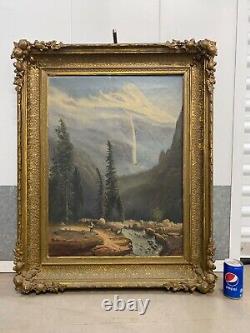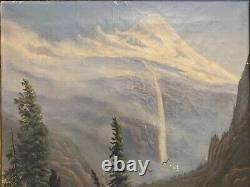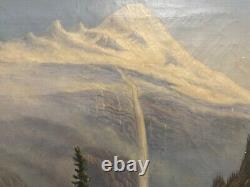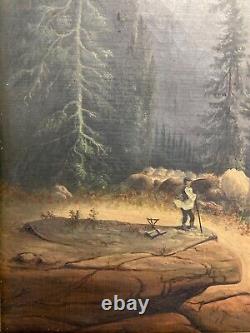
- Index
- Listed By
- Material
- Size
- Style
- Abstract (20)
- Abstract, Modernism (6)
- Americana (5)
- Art Deco (9)
- Art Nouveau (4)
- Art, Realism (4)
- Dutch (4)
- Dutch, Realism (5)
- Expressionism (23)
- Folk Art (9)
- Impressionism (150)
- Impressionist (5)
- Modernism (12)
- Portraiture (6)
- Realism (163)
- Still Life (22)
- Traditional (10)
- Traditional, Realism (4)
- Victorian (18)
- Vintage (58)
- Other (476)
- Subject
- Unit Of Sale
Fine Antique Old 19th c. Hudson River School Landscape Oil Painting, WOW


























This is a magnificent and Fine Antique Old 19th c. Hudson River School Landscape Oil Painting on canvas, depicting a majestic Hudson River Valley scene, with tall, snowcapped peaks, forested Catskills, and a calm river winding through the center of the image. In the foreground, you can make out a lone figure with a small stool and an open book lying on the floor, looking out upon the river's edge.
The man holds a walking stick in his right hand, and this theme is very reminiscent of Wanderer Above the Sea of Fog by Caspar David Friedrich 1818. This masterful painting appears to be unsigned, which is surprising. Perhaps you recognize the artist or their work? Additionally, there is an old framer's label from Jones, Wooll & Sutherland, San Francsico, which was active during the 1860's. This artwork likely dates to the 1850's - 1860's. Approximately 25 1/4 x 31 1/2 inches including frame. Actual artwork is approximately 18 x 24 inches. Very good condition for age, with some light craquelure to the canvas, a few faint scratches to the painted surface, and mild scuffing and edge wear to the impressive period ornate gilded frame. I have a strong feeling that this probably the work of a famous artist. Acquired from an old family collection of New York Hudson River school paintings and American Folk art pieces in Los Angeles County, California. If you like what you see, I encourage you to make an Offer. Please check out my other listings for more wonderful and unique artworks! About the Hudson River School. Summary of The Hudson River School. Searching for a national style of art, the American landscape itself - large and untamed - was the primary focus of the Hudson River School painters. American expansion and Manifest Destiny imbued the untamed countryside with the symbolism of the country's promised prosperity and limitless resources. The terrain provided an alternative to European culture and history; it became a picturesque, patriotic, and inspirational theme. This loosely connected group of painters explored the nation, returning to their New York studios to paint large-scale works that thrilled audiences and celebrated the awesome power of nature and the progress of man.Long considered a profitable, but lowly, subject for serious artists (since it involved merely copying what was seen), landscape painting received new attention in the mid-19. Painters in Britain and Germany, Hudson River School artists embraced the landscape as a meaningful subject, precisely as industrialization began to change terrains and reshape man's connection to his environment. The Americans both championed these forces of modernization and lamented what was lost in the name of progress. The Hudson River School painters desired a more native tradition, painting recognizably American scenes. Personally and professionally, they formed networks with writers and philosophers to create a distinct American culture.
Invested the landscape with symbolism, suggesting that these natural scenes could be transformed into meaningful allegories, as well as immersive and transformative experiences for the viewer. With their careful attention to realism and precise illusionism, as well as complex messaging and awe-inspiring vistas, the resulting canvases could be appreciated on both intellectual and emotional levels. The second generation of Hudson River School painters left the New York area to explore more far-flung regions of America. Their painting documented westward expansion and reinforced the concept of Manifest Destiny.
During the Civil War, their majestic images of an unspoiled West provided hope for post-war reconciliation and the promise of expanses of wild country, full of promise and unscarred by battle.

